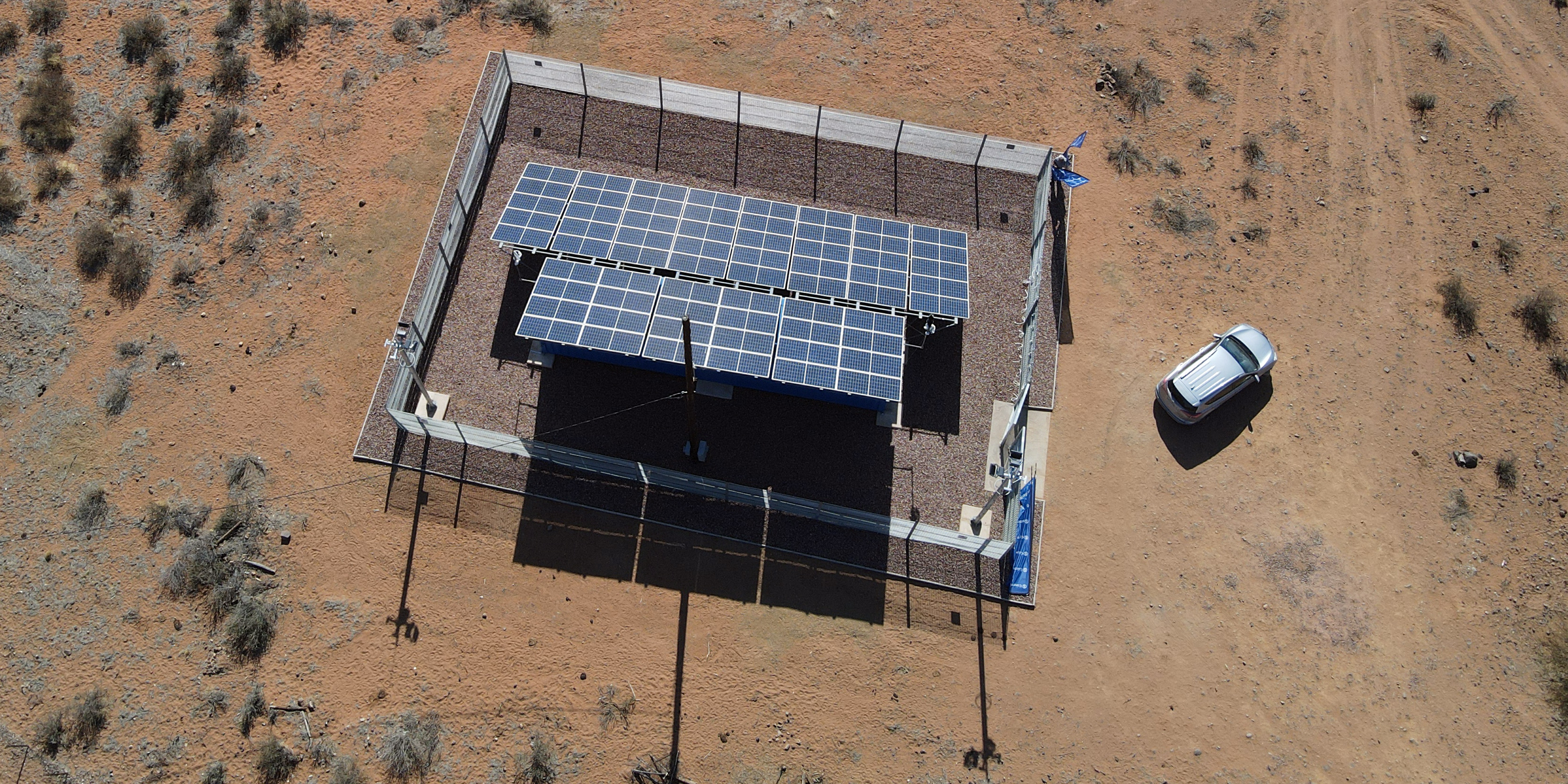On Friday morning, Eskom marked another milestone in its foray into the world of decentralised energy systems with the launch of a containerised microgrid electrification project in a remote corner of the Northern Cape.
At the end of 62km of tarred road followed by 90km of unforgiving, rocky gravel road, the tiny dorp of Swartkopdam has long been illuminated by candlelight and heated by wood fire. Simply too far – and the topography not conducive – to connect to wires that transmit electricity to the rest of South Africa, Swartkopdam has never had electricity.
 From left: Northern Cape Premier Dr Zamani Saul, Public Enterprises Minister Pravin Gordhan and Eskom group chief executive for distribution Monde Bala unveil the minigrid system in Swartkopdam on 21 July 2023. (Photo: Ethan van Diemen)
From left: Northern Cape Premier Dr Zamani Saul, Public Enterprises Minister Pravin Gordhan and Eskom group chief executive for distribution Monde Bala unveil the minigrid system in Swartkopdam on 21 July 2023. (Photo: Ethan van Diemen)
That is no longer the case. Since late December 2022, a solar panel array of some 43kW has provided near limitless electricity to the community of roughly 40 homes.
According to the World Bank, 89.3% of South Africa’s population had access to electricity in 2021. This is a significant increase from the 34% in 1994, the year that apartheid ended.
The increase in electrification has been largely attributed to the intervention of the South African government and Eskom and programmes such as the Integrated National Electrification Programme (INEP).
Northern Cape Premier Dr Zamani Saul acknowledged this reality. He mentioned how in the Northern Cape, 95% of homes have electricity. Speaking to the crowd in Afrikaans, Saul said that with this project, they were adding more to this percentage.
Also speaking at the official launch of the project, Public Enterprises Minister Pravin Gordhan shared his congratulations on bringing “the light to this part of South Africa” to the stakeholders present. Gordhan went on to explain that the Northern Cape is going to be “the home of most of the renewable energy investments [in South Africa] in the future.”
 The solar array powering the Swartkopdam community (Photo: Ethan van Diemen)
The solar array powering the Swartkopdam community (Photo: Ethan van Diemen)
South Africa is in the midst of what it calls a Just Energy Transition, where the country will shift from a legacy of electricity generation overwhelmingly dominated by pollutive coal-fired power plants in the east of the country to a future where renewable energy contributes a larger share of generation capacity. Much of that infrastructure will be based in the west of South Africa in the Western and Northern Cape with their substantial levels of solar and wind energy potential.
Read more in Daily Maverick: How renewable energy can help uplift small, poor South African towns
In a study conducted by the University of Oxford’s Environmental Change Institute, published in April 2022, South Africa and Egypt were identified as the most favourable African countries for renewable energy development and investments.
Among the findings of the study, based on an analysis of the African continent, was that South Africa “offers favourable conditions for wind installations due to high wind speeds (12m/s at 100m height), high fossil fuel electricity reliance (213-billion kWh), good political stability, and adequate techno-economic factors”. Dr Doorga Jay Rovisham Singh, a lecturer at Université des Mascareignes and lead author of the study, told Daily Maverick that “SA has one of the best solar and wind potentials of the entire African continent”.
 The entire microgrid fits into a standard sized container (Photo: Ethan van Diemen)
The entire microgrid fits into a standard sized container (Photo: Ethan van Diemen)
The Northern Cape in particular offers favourable conditions for the development of solar energy generation. Nick Singh, Smart Grid Centre of Excellence manager at Eskom’s Research and Development department agreed.
Speaking to Daily Maverick, he explained that Swartkopdam receives an average of 10 hours of sunlight a day, which when combined with the size and modular nature of the microgrid is more than enough to supply the residents of the town with all their electricity needs.
 The lithium ion batteries that store the energy to be converted into electricity when needed. (Photo: Ethan van Diemen)
The lithium ion batteries that store the energy to be converted into electricity when needed. (Photo: Ethan van Diemen)
He said that this is a tangible example of how Eskom can provide innovative solutions to deliver electricity generation to far-flung towns either too far from or geographically incapable of being connected to the grid. All with the necessary infrastructure fitting neatly into an ordinary shipping container.
Hammering this point home on Friday, Gordhan said “even if the long wires don’t come, electricity will come”.
According to Eskom group chief executive for distribution, Monde Bala, the utility has identified and budgeted – for this financial year – for at least 100 similar projects to be rolled out across the country. DM




 The lithium ion batteries that store the energy to be converted into electricity when needed. (Photo: Ethan van Diemen)
The lithium ion batteries that store the energy to be converted into electricity when needed. (Photo: Ethan van Diemen) 